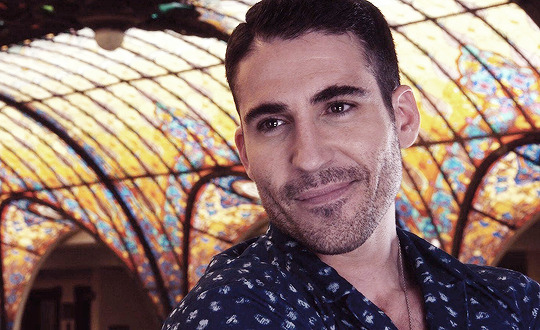Text
Intersectionality in Sense8
Intersectionality which is depicted in popular aspects of culture, like the Netflix series Sense8, is not only necessary but overtly appreciated from audience members. Intersectionality refers to those who obtain multiple marginalized identifications, such as being Black and being a woman. Representation of these variations of often misunderstood characteristics provides an outlet for audience members who can relate to the characters portrayed on the screen. Unfortunately, many people who obtain multiple stigmatized identifications are not represented on screen as often as white, straight characters, or those with one identity which does not align with characteristics normalized in society. Underrepresentation of these existing combinations of identifications is problematic when considering the prevalence of these characteristics off screen, and is instead making the assumption these combinations of characteristics do not exist by choosing to ignore their existence. Excluding combinations of marginalized identifications supports the inaccurate stereotypes by falsely guiding audience members into complete ignorance of the existence of someone with a variety of stigmatized characteristics, along with the unique experience of discrimination which follows. These people who identify as such are often persuaded to believe people who look like them, or obtain the same characteristics are either not as significant as the people usually on screen or believe they simply do not exist. However, Sense8 portrays a majority of the characters as obtaining a variety of marginalized identifications and utilizes such diverse storylines in a genuine and accurate way.

Netflix’s Sense8 portrays a variety of unique characters: including a Black man named Capheus who lives in Kenya; Lito, a gay, Spanish actor; a Korean woman named Sun; Will, a White Chicago police officer; Kala, a religious Indian pharmacist; Wolfgang, a German thief; Nomi, a trans-woman who lives in San Fransisco and is in an openly gay relationship with a Black woman named Amanita; and an Icelandic D.J. named Riley.
youtube
Sense8 is a combination of genres in itself, including aspects of sci-fi and mystery, drama, romance, action, and melancholy. “Sense8 follows eight people from vastly different backgrounds all across the world whose lives begin to gradually intertwine when they discover that they can share a mental link with one another” (Seligson). The group of eight characters are able to share their thoughts, experiences, and skills with one another. Below is the official Netflix trailer of the third season, which was shortened into a movie after Netflix’s abrupt and controversial cancellation of the series;
youtube
The condensed movie was released on June 8th, 2018, and is almost three hours long.
The characters depicted in Sense8 are unique from one another and vary from the usual main characters presented in series. The diverse characteristics between the characters allows for a diverse audience to relate to the specific characters they believe best represent them. The show not only provides physical representation of their unique characteristics, but also shares a personalized and genuine background of each of the characters. “I don’t want to reduce Sense8 to a single message, but I also want to applaud it for it’s progressivism. No other show on television comes close to the level of inclusion and representation it has, and it doesn’t get nearly enough credit for that” (Seligson). For instance, Nomi Marks is a political blogger who has a great amount of experience with online hacking. She is from San Francisco and is in an openly gay relationship with a woman named Amanita (Orley). “However, Nomi’s life is not as simple as we believe, but that she was born in the body of Michael” (Kevin). Nomi is a trans-woman and is played by Jamie Clayton, a trans-woman actor. The series provides the audience with the upsetting storyline of Nomi’s unaccepting mother who continues to call Nomi, Michael.

The next character, Lito, is a closeted gay Spanish actor in Mexico. He constantly pressures himself to appear straight to the public, although Lito is in love with a man Hernando who secretly lives with Lito. Lito is a determined actor who is continuously attempting to create a successful career. With support from Hernando and others, Lito decides to come out as gay to the audience (Orley).

Will Gorski is a Chicago police officer who obtains a major role in Sense8. Will and Riley meet in the beginning and discover they are falling in love with one another. The series shares a fight between Will and his dad who struggles with alcohol addiction and unfortunately dies after falling down a flight of stairs (Orley).

RIley is originally from Iceland but ran away when she was younger and D.J.s in England. She had a troubled past and as a result is involved in the drug trade. She is in a relationship with Will (Orley).

Wolfgang is from Germany and is a professional safe-cracker. He is constantly involved in world-class jewel heists with a close friend, as well as organized crime (Orley).

Kala lives in India and is praised for studying medicine and pharmacy. Sense8 shares Kala’s life as religious and structured. During the beginning of season one, Kala struggles with the reality she is about to marry someone she does not love due to Kala’s dad’s arrangement. Kala and Wolfgang begin seeing each other often and consider being in a romantic relationship (Orley).

Capheus is a bus driver and care-taker in Kenya. His mom is sick throughout the series, and Capheus is determined to receive the money needed to purchase medication. Capheus is a passionate, knowledgable character (Orley).

The last main character of the eight is Sun, who is a Financial Officer in South Korea. Sun enjoys kickboxing, and is often helping the other seven use the strength and talent she obtains to get out of dangerous situations when needed. Additionally, Sun’s younger brother is caught in a work-related crime and Sun is challenged with the choices of listening to her diseased mother’s advice of always protecting family, or choosing not to make the ultimate sacrifice and instead allow herself to succeed (Orley).

These diverse characters, “were born at the exact same moment on the exact same day, are physically connected, even as they live radically different lives” (Xiao). However, their unique experiences and intersecting, or not intersecting, identifications allow them to still exist as separate beings. As the audience is able to see throughout the series, these characters experience a variety of disadvantages or privileges solely because of their identifications. For instance, Nomi, the gay, trans-woman, is constantly verbally abused and maliciously misgendered by her own mother because Nomi is a trans-woman. Additionally, she is dating another woman, which Nomi’s mother disapproves of as well. The disadvantages of being both a trans-woman and identifying as gay are significantly different than another white woman identifying as gay, or solely being a trans-woman but being exclusively attracted to men. There are plenty of examples within Sense8 about intersectional experiences; including, Sun who is Korean and a woman who enjoys kickboxing. Sun lives in Korea, so she is not visibly discriminated against for being Korean, but she is often doubted for being a woman in a high-profile work setting in which the stereotypes are influenced by Korean culture. Additionally, Sun is strong and can arguably win in a majority of the kickboxing fights she participates in. When considering the expectations for women within Korea, being an outstanding kickboxer is definitely not considered “womanly.” Sun is often doubted while in the kickboxing range, and when she is at work she is seen as passive when considering Sun’s relationship with her younger brother.
The representation of diverse identifications within Sense8 only increases a range of audience members by allowing more people to relate to unique experiences which commonly occur within marginalized communities. Though the series may have cancelled due to diversity and specific experiences not everyone is able to relate to, the show resonated and continues to empower particular groups of people (Aguado-Peláez). “The series has found a firm niche among primarily queer audiences largely due to its highly visible and progressive representations of gay, lesbian, trans, and otherwise-queer bodies, sexualities, and subjectivities. This might be one of the its most redeeming, or perhaps the most redeeming, aspects...Sense8 resonates with queer folx and people of colour...The representation of queerness in Sense8 is normalized, it never seeks to be assimilationist or heteronormative. Instead, it presents the queerness of its cluster in opposition to hetero-patriarchal and corporate agendas” (Elrod). The representation of stigmatized characteristics is significant when considering viewers who are searching for authentic, accurate experiences to relate to, especially younger audience members who may be desperate for a role model.
youtube
Though Sense8 is obviously inclusive, critics discuss the problematic approach of understanding stigmatized characteristics to be true by stereotyping the characters within the show, and then attempting to argue these same stereotypes do not exist. “This kind of anti-stereotype criticism, though still important to undertake, often derives from and reaffirms the prevailing paradigm” (HSU). Therefore, critiques suggest Sense8 creators essentially believe the stereotypes as true. Additionally, some audience members believe the screen time of racially stigmatized groups in the show did not equate to the screen time given to white characters like Will or RIley. “The notion that having more diversity runs afoul of some sort of narrative economics is predicated on the idea that all characters need equal screen time” (Menken). Any piece of media can be improved in order to achieve a more inclusive character base, but Sense8 is arguably one of the most inclusive series on Netflix.
Works Cited;
Aguado-Peláez, D. “Bodies as Mapping of Resistances: Intersectional Analysis of Sense8.” CAB Direct, 2016, https://www.cabdirect.org/cabdirect/abstract/20173244288.
Elrod, James. ‘“I am also a we”’ The Interconnected, Intersectional Superheroes of Netflix’s Sense8.” Panic at the Discourse: An Interdisciplinary Journal, 2019, https://www.panicdiscourse.com/wp-content/uploads/2019/04/47-57-I-am-also-a-we%E2%80%99-.pdf
HSU, Ruth. “Collective Individuation and Radical Identity in Netflix’s Orange is the New Black and Sense8.” Race and Cultural Practice in Popular Culture, 2019, https://books.google.com/books?hl=en&lr=&id=iPy9DwAAQBAJ&oi=fnd&pg=PT24&dq=intersectionality+and+sense8+academic+source&ots=mrVmBOvnFq&sig=g67XPBY1R8wJOlezP4zi7bWv_As#v=onepage&q&f=false
Kevin. “The Importance of Sense8.” Kevin’s Thoughts, Ramblings and Everything In Between, 1 June 2017, https://abnerkd.wordpress.com/2017/06/01/sense8-2/
Menken, Sean. “Intersectionality and Sense8.” Another Gamer Guy, 29 July 2015, https://anothergamerguy.wordpress.com/2015/06/26/intersectionality-and-sense8/.
Orley, Emily. “Everything You Need To Know About The Eight Main Characters In ‘Sense8.’” BuzzFeed News, 28 May 2015, https://www.buzzfeednews.com/article/emilyorley/everything-you-need-to-know-about-the-eight-main-characters
Seligson, Jason. “SENSE8 Is The Show We Need Now More Than Ever.” Birth.Movies.Death, 27 Apr. 2017, https://birthmoviesdeath.com/2017/04/27/sense8-is-the-show-we-need-now-more-than-ever
Xiao, et al. “Celebrating Intersectionality in the Futuristic Netflix Series 'Sense8.’” Hyperallergic, 20 Feb. 2017, https://hyperallergic.com/349182/celebrating-intersectionality-in-the-futuristic-netflix-series-sense8/.
1 note
·
View note